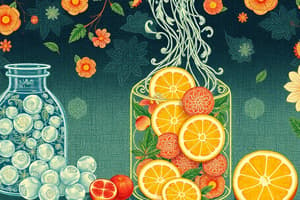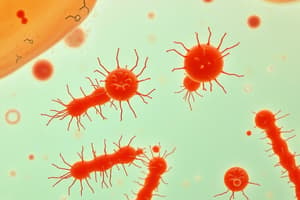Podcast
Questions and Answers
What is a primary benefit of reducing pH in food preservation?
What is a primary benefit of reducing pH in food preservation?
- Enhances food color
- Improves food texture
- Inhibits microbial growth (correct)
- Increases nutrient content
What is the main purpose of fermentation in food processing?
What is the main purpose of fermentation in food processing?
- To convert sugars into organic acids (correct)
- To freeze food for preservation
- To enhance water activity
- To increase the pH of the food
Which lactic acid bacteria is noted for its ability to grow at low pH levels?
Which lactic acid bacteria is noted for its ability to grow at low pH levels?
- Bacillus subtilis
- Lactobacillus (correct)
- Listeria monocytogenes
- Escherichia coli
What method involves chopping food into small pieces to ensure acid penetration?
What method involves chopping food into small pieces to ensure acid penetration?
In the fermentation process, what happens to the sugar concentration?
In the fermentation process, what happens to the sugar concentration?
Which food is commonly fermented using lactic acid bacteria?
Which food is commonly fermented using lactic acid bacteria?
What is the typical pH achieved during successful fermentation of food?
What is the typical pH achieved during successful fermentation of food?
Which of the following describes a limitation of acid diffusion in oily foods?
Which of the following describes a limitation of acid diffusion in oily foods?
What is the importance of shredding cabbage into small pieces during sauerkraut production?
What is the importance of shredding cabbage into small pieces during sauerkraut production?
What percentage of salt is generally used in sauerkraut production?
What percentage of salt is generally used in sauerkraut production?
In the vinegar fermentation process, what does the Acetobacter bacteria require for its function?
In the vinegar fermentation process, what does the Acetobacter bacteria require for its function?
Which method describes the semi-continuous fermentation process used in traditional French vinegar-making?
Which method describes the semi-continuous fermentation process used in traditional French vinegar-making?
What is the primary reason for draining off most of the vinegar during the Orleans process?
What is the primary reason for draining off most of the vinegar during the Orleans process?
In a trickle fermenter, what role do the wood shavings or substrate play?
In a trickle fermenter, what role do the wood shavings or substrate play?
What toxic compound is generated during sauerkraut fermentation that must be managed?
What toxic compound is generated during sauerkraut fermentation that must be managed?
How does the proton gradient benefit the cell during sauerkraut fermentation?
How does the proton gradient benefit the cell during sauerkraut fermentation?
Flashcards
Fermentation
Fermentation
Microorganisms like bacteria and yeasts can transform food through controlled fermentation, leading to changes in flavor, texture and preservation.
Lactic Acid Fermentation
Lactic Acid Fermentation
A process where microorganisms convert sugars or other carbohydrates into acids, like lactic acid, which lowers the pH of the food, making it less hospitable to harmful bacteria and extending its shelf life.
Water Activity (Aw)
Water Activity (Aw)
A measure of the amount of free water available in food. It is lower in fermented foods due to the reduction in water activity by fermentation.
Organoleptic Changes
Organoleptic Changes
Signup and view all the flashcards
Acidification
Acidification
Signup and view all the flashcards
Pickling
Pickling
Signup and view all the flashcards
Fermentation (Internal)
Fermentation (Internal)
Signup and view all the flashcards
Lactobacillus
Lactobacillus
Signup and view all the flashcards
Vinegar fermentation
Vinegar fermentation
Signup and view all the flashcards
Orleans process
Orleans process
Signup and view all the flashcards
Acetobacter bacteria
Acetobacter bacteria
Signup and view all the flashcards
Trickle fermenter
Trickle fermenter
Signup and view all the flashcards
Solid state fermentation
Solid state fermentation
Signup and view all the flashcards
Salting cabbage
Salting cabbage
Signup and view all the flashcards
Ethanal
Ethanal
Signup and view all the flashcards
Study Notes
Beneficial Microbial Activity in Food Production
- Microbial activity isn't always detrimental; it plays a crucial role in food production.
- Microorganisms are used in fermenting various foods like meat, vegetables, and dairy products.
- Single-cell protein (SCP) and vinegar production also involve microbial processes.
Preservative and Flavor Effects
- Microorganisms create foods through preserving effects and flavor changes.
- Preservative effects include lower pH and water activity (Aw).
- Flavor effects involve organoleptic changes, such as alterations in texture.
Lowering pH for Microbial Control
- Most microbes stop growing below pH 4.
- Lactobacillus bacteria can thrive at lower pH levels and are utilized in fermentation.
Methods of Acidification
- Pickling: Adding acid (acetic or lactic) to food. Requires chopping food into small pieces to promote acid diffusion from outside in.
- Fermentation: Microbes work inside food, like vegetables or meat, to lower the pH. Does not rely on outward diffusion.
Fermented Vegetable Production
- Sauerkraut:
- Fresh cabbage is shredded thinly and mixed with salt.
- Salt creates an environment for lactic acid bacteria, changing flavor, and lowering pH.
- Salt concentration is crucial, with > 2% potentially softening the product.
Vinegar Fermentation Methods
-
Orleans Process (Traditional):
- Semi-continuous, where wine is added, and vinegar is drained, utilizing leftover bacteria from the previous batch as starter culture.
- Acetobacter is housed at the top due to oxygen requirement.
-
Trickle Fermenter (Modern):
- Continuous fermentation system.
- Alcohol is added continuously, and vinegar is collected continuously.
- Solid substrate, like wood shavings, supports the growth of Acetobacter.
Studying That Suits You
Use AI to generate personalized quizzes and flashcards to suit your learning preferences.




